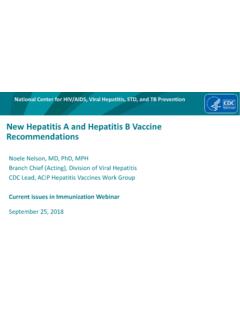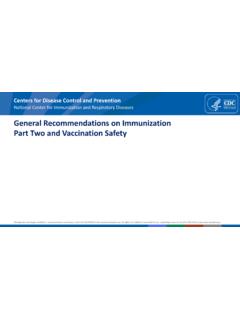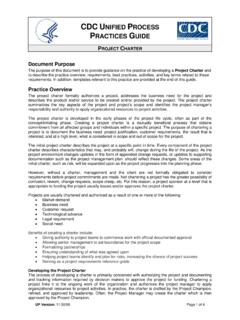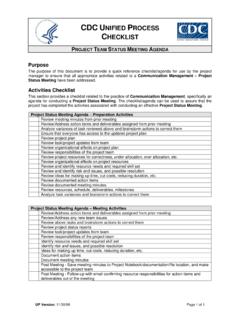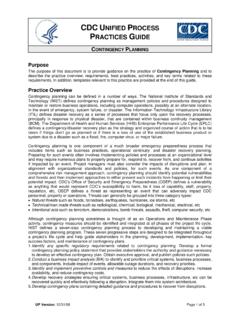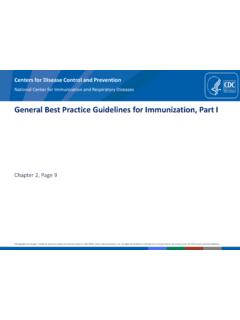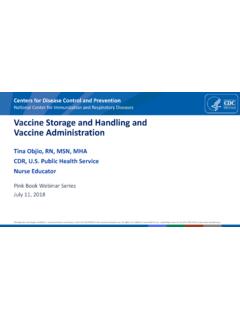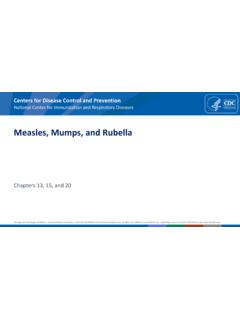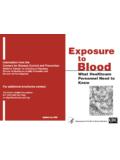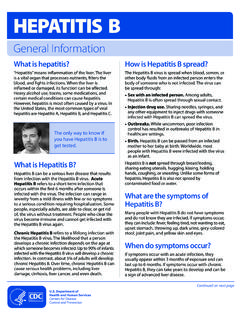Transcription of Hepatitis B and Hepatitis B Vaccine
1 Centers for Disease Control and PreventionNational Center for Immunization and Respiratory DiseasesCenters for Disease Control and PreventionNational Center for Immunization and Respiratory DiseasesCenters for Disease Control and PreventionNational Center for Immunization and Respiratory DiseasesCenters for Disease Control and PreventionNational Center for Immunization and Respiratory DiseasesPhotographs and images included in this presentation are licensed solely for CDC/NCIRD online and presentation use. No rightsare implied or extended for use in printing or any use by other CDC CIOs or any external B and Hepatitis B VaccineDisease1 Hepadnaviridaefamily (DNA) Numerous antigenic components May retain infectivity for more than 7 days at room temperatureHepatitis B VirusHepatitis B Virus Infection786,000deaths worldwide 850,000 millionUS chronic infections257 millionchronic infections worldwide Causes50%of hepatocellular #bFAQb04 ReservoirHuman Transmissionpercutaneous ( , puncture through the skin) or mucosal contact with infectious blood or body fluids ( , semen, saliva)
2 Communicability1-2 months before and after onset of symptomsPersons with either acute or chronic HBV infection with HBsAgpresent in bloodHepatitis B Epidemiology Incubation period 60-150 days (average 90 days) Nonspecific prodromeof malaise, fever, headache, myalgia Children < 5 years and newly infected immunosuppressed adults generally asymptomatic 30% 50% of persons aged 5 years have signs and symptomsHepatitis B Clinical Features Fulminant Hepatitis (<1%) Hospitalization Cirrhosis Hepatocellular carcinoma DeathHepatitis B Complications Injection drug use 2 or more sexual partners Men who have sex with men Household contacts of persons with HBV Developmentally disabled persons in long-term-care facilities Correctional facilities Persons at risk for occupational exposure to HBV Hemodialysis patients Persons with HCV infection Persons with chronic liver disease Travelers to countries where HBV is endemic Persons with HIV Persons with DiabetesRisk Factors for Hepatitis B 80-90% of persons infected during infancy 30% of persons infected before age 6 years 1-12% of persons infected as an older child or adult Approximately 25% of persons chronically infected during childhood and
3 15% chronically infected after childhood will die prematurely from cirrhosis or liver cancerChronic Hepatitis B Virus InfectionRisk of Chronic HBV InfectionJ Hepatol. 2008;48(2):335-52020406080100 Birth1-6 mo7-12 mo1-4 yrs5+ yrsChronic Infection risk(%)Age of infection Immune tolerant Minimal or no hepatic inflammation or fibrosis Immune active Hepatic inflammation with or without fibrosis Immune inactive Improvement of hepatic inflammation and fibrosis Reactivation Active hepatic inflammation with or without fibrosisChronic Hepatitis B Virus Infection 4 PhasesHepatitis B Perinatal Transmission**in the absence of post exposure prophylaxis HBsAg+ & HBeAg+HBsAg+ only70-90% infected10% infectedUp to 90% ofinfected infants become chronically infected Prevent perinatal HBV transmission Routine testing of all pregnant women for HBsAgoProphylaxis (HepBvaccine and HBIG)
4 For infants born to HepBsurface antigen (HBsAg) positive womenoHBV DNA testing for HBsAgpositive women and antiviral therapy if HBV DNA is >200,000 IU/mL Universal vaccination of all infants at birth Routine vaccination of previously unvaccinated children and adolescent (<19 years of age) Vaccination of adults at risk for HBV infectionStrategy to Eliminate Hepatitis B Virus Transmission United #B2_downNew!Vaccine2 Hepatitis B-Containing Vaccine Products**ACIP does not state a preference for Vaccine product versus another if the patient is eligible for more than 1 product VaccineproductAge indicationsSingle-component vaccinesEngerix-BPediatric formulationBirth 19 yearsAdult formulation20 years and olderRecombivaxHBPediatricformulationBirth 19 yearsAdult formulation20 years and olderHeplisav-B18 years and olderCombination vaccinesPediarix D Ta P, IPV and HepBvaccines 6 weeks 6 yearsTwinrix HepAand HepBvaccines 18 years and olderRecombivax HBDose (mcg)Engerix-B*Dose (mcg)Heplisav-BDose (mcg)Children:Birththrough 19 mL (5) mL (10)N/A: <17 mL (20): >18 yrsAdults.
5 20 years and mL(10) mL(20) mL (20)Recommended Dosage of HepBVaccine*Pediarixcontains the pediatric formulation of Engerix-B*Twinrixcontains the adult formulation of Engerix-B Heplisav-B approved for use in persons 18 years of age or olderRecombivax HBDose (mcg)Engerix-B*Dose (mcg)Heplisav-BDose (mcg)CompositionRecombinant HBsAgRecombinant HBsAgAdjuvantedRecombinant HBsAgEfficacy95% (Range, 80% 100%)95% (Range, 80% 100%)90% 100%Schedule3 doses3 doses2 dosesRouteIMIMIMHepBVaccine*Pediarixcont ains the pediatric formulation of Engerix-B*Twinrixcontains the adult formulation of Engerix-B PediarixDTaP/IPV/HepB Ages: 6 weeks through 6 years Routine schedule: 2, 4, 6 months of age Approved for dose 1, 2, 3 of HepB (Do NOT use for the birth dose) TwinrixHepA/HepB Ages: 18 years of age and older Routine schedule:3 doses at 0, 1, 6 months, or 0, 7, 21-30 days and a booster dose at 12 months Each dose of Twinrixcontains an adult dose of Hepatitis B Vaccine A HepBseries started with Twinrixcan be complete with single antigen HepBvaccine and vice versaCombination Vaccines Clinical Considerations3 Routinely recommended for all children birth through 18 years of age Vaccinate previously unvaccinated children and those missing doses ACIP HepB Vaccine Recommendations: Pediatric Dose+Routine Age Dose 1 Birth Dose 21- 2 monthsDose3+6-18 months*HepB Schedule.
6 Routine Infant The birth dose of single-component Hepatitis B Vaccine should be administered within 24 hours of birth for medically stable infants weighing 2,000 grams born to Hepatitis B surface antigen (HBsAg)-negative mothers.*Infants whose mothers are HBsAg+ or whose HBsAgstatus is unknown should receive the third dose at 6 months of age+An additional dose at 4 months is acceptable if the clinician prefers to use a combination Vaccine that contains Hepatitis B vaccineHepBSchedule: Minimum Age and Intervals 4- day grace can be applied to minimum age and intervals 16 weeks123 DOSEDOSEDOSE4 weeks8 weeks6 months = minimum ageCan be given to infants who received HepBat birth = 4 doses*Do NOT use for the birth dosePediarixSchedule Considerations *An additional dose at 4 months is acceptable if the clinician prefers to use a combination Vaccine that contains Hepatitis B Vaccine 1 DOSEB irthEngerixB or RecombivaxHBDOSE22 monthsPediarixDOSE34 monthsPediarixDOSE46 months is the minimum age for the last dose 6 monthsPediarixBirth Dose Considerations.
7 Babies Weighing 2000 grams or more *Administer HepBvaccine and HBIG in separate limbs Administer HepBvaccine within 24 hours of birth HBsAgNEGATIVE mother HBsAgPOSITIVE mother HBsAgUNKNOWN mother Administer HepBvaccine and HBIG* within 12 hours of birth Administer HepBvaccine within 12 hours of birth and test to determine mother s status ASAP Birth Dose Considerations: Babies Weighing Less Than 2000 grams *Administer HepBvaccine and HBIG in separate limbs Administer HepBvaccine at hospital discharge or at 1 month of age HBsAgNEGATIVE mother HBsAgPOSITIVE mother HBsAgUNKNOWN mother Administer HepBvaccine and HBIG* within 12 hours of birth Administer HepBvaccine within 12 hours of birth. Give HBIG, if the mother s HBsAgstatus cannot be determined within 12 hours of birth* Administer HepBvaccine and HBIG within 12 hours of birth HepBvaccine and HBIG can be administered at the same time HepBand HBIG are both IM injections Administer in different limbs Complete vaccination series at 6 months of age 1stdose does not count when administered to infants weighing less than 2000 grams Test for response after completing a 3-dose series at 9 through 12 months of ageMedical Considerations.
8 Treating Infants Whose Mother is Hepatitis B Surface Antigen POSITIVE Infants born to women without HBsAgtesting results but other evidence suggests maternal HBV infection exists, administer both HepBand HBIG within 12 hours of birth Test mother for HBsAGstatus as soon as possible Infants weighing 2000 grams or more: If mother is determined to be Hepatitis B surface antigen positive give HBIG as soon as possible, but no later than age 7 days Infants weighing less than 2000 grams: If the mother tests positive or HBsAGstatus can not be determined, administer HBIG within 12 hours of birth Medical Considerations: Treating Infants Whose Mother is Hepatitis B Surface Antigen UNKNOWN Prevaccinationserologic testing is: Not indicated before routine vaccination of infants or children Recommended for all persons born in Africa, Asia, the Pacific Islands, and other regions with HBsAgprevalence of 2% or higher Postvaccinationserologic testing is: Not routinely recommended following vaccination of infants, children, and adolescents Recommended for infants born to HBsAg+ womenSerologic Testing and Children Vaccination recommended unvaccinated adults at risk for HBV infection and adults requesting protection from HBV infection Acknowledgement of a specific risk factor not required vaccinationACIP HepB Vaccine Recommendations.
9 Adult Hepatitis C virus infection Chronic liver disease HIV infection Sexual exposure riskAdults at Risk for HBV Infection* Persons with more than one sex partner during the previous 6 months Current or recent injection drug use Percutaneous or mucosal risk for exposure to blood Incarcerated persons Travel in countries with high or intermediate endemic Hepatitis BAdults at Risk for HBV Infection* Persons with more than one sex partner during the previous 6 months DoseRoutineIntervalMinimum IntervalDose 1------Dose 21 month4 weeksDose 3 6 months8 weeks andat least 16 weeks from Dose 1 HepBSchedule: AdultRecombivaxHB or Engerix-B StorageStore in the refrigerator between 2 C and 8 C (36 F and 46 F)Ages18 years of age and older Schedule Administer 2 doses separated by 4 weeks AdministrationIntramuscular (IM) injection in the deltoidCan be administered at the same clinical visit as other vaccines.
10 Administer in separate injection sites, 1 inch apart (if possible)Contraindication History of severe allergic reaction ( , anaphylaxis) after a previous dose of any Hepatitis B Vaccine or to any component of Heplisav-B, including yeastHeplisav-B (HepB-CpG)Heplisav-B package insert. Accessed 4/2018 2-dose HepB series only applies when BOTH doses are Heplisav-B, administered at least 4 weeks apart Any 2 doses of Heplisav-B separated by 4 weeks is considered complete, even if the patient has had other HepBvaccine products Until safety data are available for Heplisav-B, providers should vaccinate pregnant women needing HepB vaccination with Engerix-B or RecombivaxHBAdditional Heplisav-B Considerations MMWR 2018;( ):455 58 Scenarios or RecombivaxHB01/01/2018 HepB-CpGHeplisav-B02/01/2018 HepB-CpGHeplislav-B03/01/2018 Completed s
